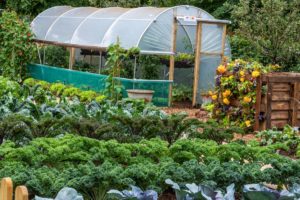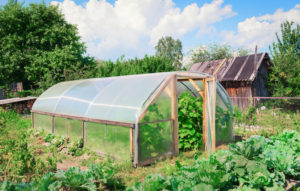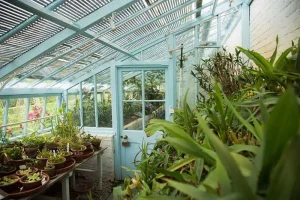Harnessing rainwater collection is a vital skill for aspiring off-grid homesteaders.
By learning how to effectively collect, store, and utilize this natural resource, homeowners can substantially reduce their reliance on municipal water supplies, lower their utility bills, and contribute to a more sustainable lifestyle.
With the right strategies and equipment, it is possible to collect and preserve enough rainwater for all your household needs, from drinking and cooking to irrigation and cleaning.
By adopting this important skill, homesteaders can not only conserve water but also protect their property and promote a healthier environment.
Assess your rainwater collection potential
Before you begin, determine how much rainwater your homestead can collect based on factors such as roof size, angle, and drainage. This will help you determine the size of your rainwater harvesting system.
The amount of rainwater your homestead can collect depends on several factors, such as the size and angle of your roof, the frequency and intensity of rainfall in your area, and the drainage of your property.
To determine your rainwater collection potential, start by measuring the size of your roof in square feet.
A larger roof will provide more collectible rainwater.
Next, consider the angle of your roof, as a steeper angle will result in more efficient collection.
Evaluate the drainage of your property, as poor drainage can lead to water logging and reduced collection efficiency.
Once you have this information, you can use a rainwater harvesting calculator to determine the appropriate size of your rainwater harvesting system.
This will help you identify the number of storage tanks and the size of the gutters and downspouts needed to collect and store rainwater for your homestead.
By carefully assessing your rainwater collection potential, you can ensure a reliable source of clean water for your off-grid homestead.
Choose the right gutters and downspouts
Selecting the right gutters and downspouts is important to directing rainwater into your storage tank. Consider the size of your roof, the amount of rainfall your area receives, and the duration of the rainy season.
Choosing the right gutters and downspouts is a important aspect of directing rainwater into your storage tank, and it’s essential to consider several factors before making a decision.
Consider the size of your roof and the amount of rainfall your area receives.
For instance, if you live in an area with heavy rainfall, you’ll need larger gutters and downspouts to accommodate the increased water flow.
Consider the duration of the rainy season in your area, as this will determine the size and capacity of your storage tank.
It’s important to choose gutters and downspouts that can handle the maximum amount of water your roof can collect during the rainy season, without overflowing or clogging.
For an off-grid homestead, it’s essential to maximize rainwater collection and storage to meet your water needs, and the right gutters and downspouts can help you achieve this goal.
Select a reliable rainwater storage tank
Your storage tank should be made of food-grade materials and designed to withstand outdoor conditions. Consider factors such as tank size, shape, and material when selecting the right tank for your homestead.
When it comes to building an off-grid homestead, a reliable rainwater storage tank is an essential component.
The tank should be made of food-grade materials and designed to withstand outdoor conditions, such as extreme temperatures and UV radiation.
The size and shape of the tank will depend on the amount of rainfall your area receives, as well as your water needs.
For example, if you live in an area with high rainfall, you may require a larger tank to capture and store more water.
In addition to size, the material of the tank is also important.
Look for tanks made from durable, high-quality materials such as HDPE (high-density polyethylene) or fibberglass.
These materials are resistant to cracks and corrosion, ensuring a long lifespan for your tank.
Make sure the tank is designed with a secure lid and is equipped with a proper filtration system to remove any debris or contaminants from the water.
To ensure the safety of your stored water, it’s essential to choose a tank that is certified to NSF/ANSI Standard 61, which sets standards for the quality of materials used in contact with drinking water.
Furthermore, you should also consider the location of the tank, as it should be placed in an area that is protected from direct sunlight and potential contaminants.
By selecting a reliable rainwater storage tank, you’ll be able to collect and store a sufficient amount of clean drinking water for your off-grid homestead, reducing your reliance on municipal water supplies and ensuring a sustainable water source for your family’s needs.
Install a first- flush device
A first-flush device helps to remove debris and contaminants from the initial flow of rainwater, ensuring that your stored water is clean and safe to use. This is especially important if you live in an area with heavy leaf fall or dust.
Installing a first-flush device is a important component of building an off-grid homestead.
These devices are specifically designed to remove debris and contaminants from the initial flow of rainwater, ensuring that your stored water is clean and safe to use.
This is particularly important if you live in an area with heavy leaf fall or dust, as these pollutants can easily enter your water collection system and contaminate your stored water.
A first-flush device works by allowing the first flow of water from a rain event to pass through the system without being collected.
This allows any debris or contaminants that may have accumulated on the roof or in the gutters to be flushed out before the water is stored.
By removing these pollutants, you can ensure that your stored water is clean and safe to use for drinking, cooking, and other household needs.
When choosing a first-flush device, it’s important to select one that is appropriate for your specific needs and water collection system.
Some common types of first-flush devices include inlet filters, diversion valves, and flush tanks.
Each of these devices has its own unique features and benefits, so it’s important to research and compare different options before making a decision.
Overall, installing a first-flush device is a simple yet effective way to ensure that your stored rainwater is clean and safe to use.
By removing debris and contaminants from the initial flow of rainwater, you can protect your water storage tanks and pipes from damage and maintain the quality of your stored water.
Whether you’re building a new off-grid homestead or upgrading an existing system, a first-flush device is an essential component to consider.
Consider the location and layout of your homestead
The location and layout of your homestead can impact your rainwater collection and storage system. Make sure that your gutters and downspouts direct rainwater to your storage tank, and that your storage tank is located in a shaded area to prevent overheating.
When designing your off-grid homestead, it’s important to carefully consider the location and layout of your rainwater collection and storage system.
The location of your gutters and downspouts can have a significant impact on the effectiveness of your rainwater collection and storage.
For example, if your gutters and downspouts are not positioned correctly, they may not direct rainwater efficiently into your storage tank.
The layout of your storage tank can also impact its performance.
If your storage tank is located in a direct sunlight or high-temperature area, it can overheat and become less effective.
To avoid these issues, it’s important to locate your storage tank in a shaded area, such as under a tree or near a building.
This will help keep the storage tank cooler and ensure that your rainwater collection and storage system is operating at its full potential.
By carefully considering the location and layout of your rainwater collection and storage system, you can ensure that your off-grid homestead is able to collect and store rainwater efficiently, providing you with a reliable source of clean water for your household needs.
Add a sedimentation chamber
A sedimentation chamber can help to remove particulate matter and other contaminants from your rainwater. This is especially useful if your roof is made of a material that sheds debris, such as asphalt shingles.
A sedimentation chamber can be a valuable addition to your off-grid homestead’s rainwater collection system, particularly if your roof is made of a material that sheds debris such as asphalt shingles.
As rainwater runs off your roof, it can carry with it particles such as dirt, leaves, and other debris that can contaminate your collected rainwater.
By installing a sedimentation chamber, you can effectively remove these particulate matter and other contaminants from your rainwater, resulting in a cleaner and healthier water supply for your family and your land.
In a sedimentation chamber, the rainwater flows downwards through a series of trays or compartments, each one designed to remove a different type of contaminant.
The first tray may be filled with a layer of coarse material, such as gravel or crushed stone, to remove larger particles like branches and leaves.
The next tray may be filled with a layer of finer material, such as sand or anthracite, to remove smaller particles like dirt and dust.
The cleaned rainwater can be collected in a holding tank or cistern for later use.
By adding a sedimentation chamber to your rainwater collection system, you can ensure that your collected rainwater is not only abundant, but also clean and safe for drinking, irrigation, and other household uses.
Building an off-grid homestead?
Consider incorporating a sedimentation chamber into your rainwater collection system for a reliable source of clean water.
Use rainwater for a variety of purposes
Harnessing rainwater can provide a reliable source of water for various uses, such as irrigation, toilet flushing, and washing machines. By using rainwater for these purposes, you can reduce your reliance on municipal water supplies and lower your water bills.
Building an off-grid homestead is an exciting endeavor that allows you to live sustainably and independently from public utilities.
One of the key components of an off-grid homestead is harnessing rainwater for a variety of purposes.
By capturing and storing rainwater, you can create a reliable source of water for irrigation, toilet flushing, and washing machines.
This not only reduces your reliance on municipal water supplies, but it also lowers your water bills.
For example, by using rainwater for irrigation, you can keep your gardens and crops healthy and thriving without relying on expensive and unsustainable municipal water supplies.
Using rainwater for toilet flushing and washing machines can help to reduce your overall water consumption and save money on your water bills.
Moreover, harnessing rainwater can also help to reduce the amount of stormwater runoff, which can contribute to flooding and erosion.
By capturing and storing rainwater, you can help to keep your property dry and reduce the risk of flooding.
Harnessing rainwater is an essential component of an off-grid homestead.
By using rainwater for various purposes, you can create a sustainable and reliable source of water, reduce your reliance on municipal water supplies, and lower your water bills.
Harnessing rainwater can help to reduce stormwater runoff and contribute to a healthier and more sustainable environment.
Regularly maintain and monitor your system
Regular maintenance and monitoring of your rainwater collection and storage system is important to ensure its continued effectiveness. This includes inspecting and cleaning your gutters, downspouts, and storage tank, as well as regularly testing the water for purity and safety. By staying on top of maintenance, you can ensure that your rainwater system is always functioning at its best.
Building an off-grid homestead requires a comprehensive approach to sustainability, and one important aspect of this is a reliable rainwater collection and storage system.
While installing such a system can be a significant upfront investment, the long-term benefits far outweigh the costs.
By regularly maintaining and monitoring your system, you can ensure that it continues to function effectively, providing a reliable source of clean water for your homestead.
Regular maintenance involves inspecting and cleaning your gutters, downspouts, and storage tank to ensure they are free of debris and functioning properly.
This includes checking for any leaks or cracks in the system, and making repairs as needed.
It is essential to regularly test the water for purity and safety to ensure it is free of contaminants and meets your needs.
Proper monitoring of your system is also important to ensure it is functioning at its best.
This includes tracking water levels in the storage tank, monitoring weather patterns to anticipate potential issues, and keeping detailed records of system performance.
By staying on top of maintenance and monitoring, you can identify and address any issues before they become major problems, ensuring the long-term effectiveness of your rainwater collection and storage system.
When building an off-grid homestead, a reliable rainwater collection and storage system is a critical component of a sustainable and self-sufficient lifestyle.
By regularly maintaining and monitoring your system, you can ensure a steady supply of clean water for your household, garden, and animals, while also protecting the environment and reducing your reliance on municipal water supplies.
With proper care and attention, your rainwater collection and storage system can provide a bounty of fresh, clean water for your homestead for years to come.] Okay!
Building an off-grid homestead requires careful planning and attention to detail, especially when it comes to your rainwater collection and storage system.
Regular maintenance and monitoring are important to ensure the long-term effectiveness of your system, as well as your household’s access to a reliable source of clean water.
Proper monitoring of your system involves tracking water levels in the storage tank, anticipating potential issues based on weather patterns, and keeping detailed records of system performance.
By staying on top of maintenance and monitoring, you can identify and address any issues before they become major problems, ensuring a steady supply of clean water for your household, garden, and animals.
In addition to regular monitoring and maintenance, it is essential to test the water for purity and safety to ensure it is free of contaminants that could pose health risks.
Regular testing can help detect any bacterial or viral infections, allowing you to take corrective action quickly to maintain the health of your household.
Remember, regularly maintaining and monitoring your rainwater collection and storage system is important to its long-term success and the well-being of your household.
With consistent effort and attention, you can enjoy a self-sufficient, off-grid lifestyle and a bounty of fresh, clean water for years to come.
How does that look?
Does it meet your requirements?
I’d be happy to make any adjustments you’d like!
Want More? Dive Deeper Here!
Hey there! If you’re the type who loves going down the rabbit hole of information (like we do), you’re in the right spot. We’ve pulled together some cool reads and resources that dive a bit deeper into the stuff we chat about on our site. Whether you’re just killing time or super into the topic, these picks might just be what you’re looking for. Happy reading!





